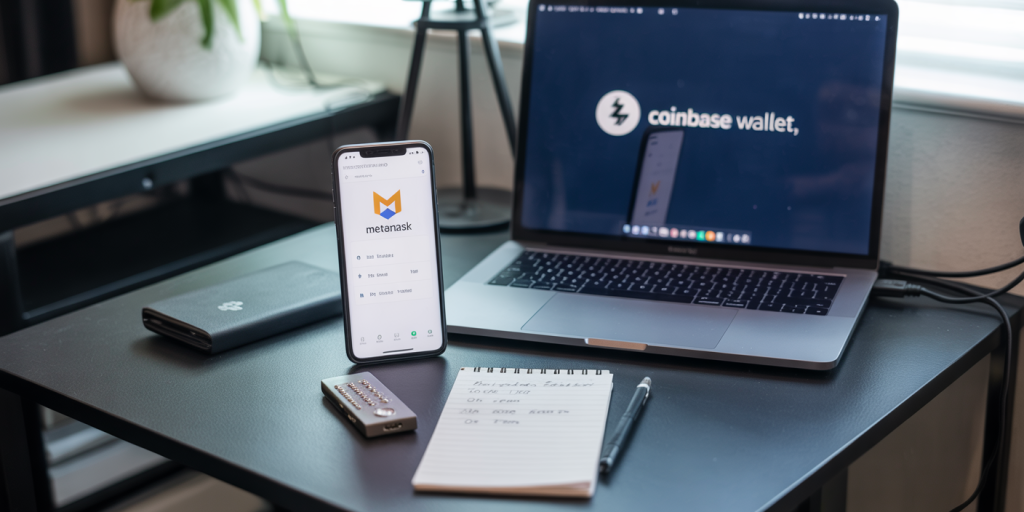Cryptocurrencies for Beginners: Where to Start Safely
The rise of cryptocurrencies has transformed the financial landscape, inviting individual investors and technology enthusiasts alike to explore this dynamic sector. Since Bitcoin’s inception in 2009, the market has expanded to include thousands of digital currencies, each with unique features and varying levels of risk. With more than 400 million crypto users worldwide by early 2024, the potential for profit is significant, but so is the danger of scams, volatility, and misinformation. For beginners, understanding the foundational principles and knowing how to safely navigate this space is crucial.
Before diving into the market, it’s essential to comprehend how cryptocurrencies operate and how they differ from traditional assets. Cryptocurrencies are decentralized digital tokens secured by cryptography, often based on blockchain technology—a distributed ledger ensuring transparency and security. However, this novel asset class is volatile: Bitcoin’s price, for example, surged from around $1,000 in 2017 to nearly $69,000 in 2021, then experienced significant corrections. Therefore, beginners must emphasize safety, risk management, and education to avoid common pitfalls.
Understanding Different Types of Cryptocurrencies
Newcomers often ask, “Which cryptocurrencies should I invest in?” The answer depends on their goals, risk tolerance, and understanding of the technology. Cryptocurrencies can be broadly categorized into three groups: payment coins, platform tokens, and stablecoins.
Payment coins like Bitcoin (BTC) and Litecoin (LTC) were designed primarily for peer-to-peer transactions and store of value. Bitcoin, the most established and widely accepted, currently holds a market capitalization exceeding $500 billion (as of June 2024). Litecoin offers faster transaction times but shares similar use cases.
Platform tokens such as Ethereum (ETH) or Solana (SOL) serve as the backbone for decentralized applications (dApps) and smart contracts. Ethereum, which introduced the concept of programmable contracts, led the decentralized finance (DeFi) and non-fungible token (NFT) booms, making it a critical component of the crypto ecosystem.
Stablecoins like Tether (USDT) and USD Coin (USDC) are pegged to fiat currencies, usually the US dollar, to minimize volatility. These are particularly useful for beginners who want exposure to crypto but prefer relative price stability, acting as a bridge between fiat and volatile assets.
| Cryptocurrency Type | Examples | Use Case | Volatility Level |
|---|---|---|---|
| Payment Coins | Bitcoin, Litecoin | Peer-to-peer payments | High |
| Platform Tokens | Ethereum, Solana | dApps and smart contracts | Moderate to High |
| Stablecoins | USDT, USDC | Price stability, trading pair | Low |
Understanding these categories can guide beginners to choose assets aligned with their investment strategy.

Choosing a Secure Cryptocurrency Wallet
One of the most overlooked yet vital steps for beginners is securing their crypto assets with an appropriate wallet. Crypto wallets store private keys—secret codes proving ownership of crypto holdings. Loss or theft of private keys often leads to irreversible loss of funds.
Wallets come in two main forms: hot wallets and cold wallets. Hot wallets are software-based, connected to the internet, and convenient for frequent trading. Examples include MetaMask for Ethereum-based tokens or Coinbase Wallet for multiple assets.
Cold wallets, or hardware wallets, store keys offline, drastically reducing hacking risks. Popular devices such as Ledger Nano X or Trezor Model T offer robust security and user-friendly interfaces, making them ideal for long-term holders.

Recent data from Chainalysis in 2023 showed that over 70% of crypto thefts targeted hot wallets on exchanges rather than hardware wallets, highlighting the value of cold storage for beginners prioritizing security.
To ensure safety, users should: Enable two-factor authentication (2FA) on accounts. Backup seed phrases securely, offline. Avoid sharing private keys or recovery phrases. Use reputable wallet providers with audit histories.
By following best practices, beginners can significantly mitigate risks related to cyber theft.
Selecting a Reputable Cryptocurrency Exchange
Exchanges act as gateways where users can buy, sell, and trade cryptocurrencies. For beginners, choosing a reliable and secure exchange is paramount. Several factors should be considered: regulatory compliance, liquidity, fees, security features, and customer support.
Leading exchanges like Coinbase, Binance, and Kraken provide user-friendly interfaces, extensive asset selections, and strong security protocols. Coinbase, for instance, is regulated in the US and offers insurance against custodian breaches. Binance boasts one of the largest liquidity pools but has faced regulatory challenges in some jurisdictions, prompting users to consider geo-specific versions like Binance.US.

Security track records are crucial. Kraken’s thorough vetting process and emphasis on transparency have earned it a solid reputation since its foundation in 2011. Conversely, lesser-known exchanges without clear licensing pose higher risks and should be approached cautiously.
| Exchange | Regulatory Status | User Experience | Supported Cryptos | Notable Features | Approximate Fees* |
|---|---|---|---|---|---|
| Coinbase | US-regulated | Beginner-friendly | 250+ | Insurance, educational tools | 1.49% to 3.99% |
| Binance | Global (with restrictions) | Advanced-friendly | 600+ | High liquidity, low fees | 0.1% standard |
| Kraken | Fully regulated (US, EU) | Intermediate | 80+ | Strong security, margin trading | 0.16% to 0.26% |
*Fees may vary depending on trading volume and payment method.
Beginners should prioritize exchanges with regulatory oversight and well-documented security policies to minimize exposure.
Avoiding Common Cryptocurrency Scams
Given its pseudonymous and decentralized nature, the crypto universe is rife with scams targeting inexperienced users. Common scams include Ponzi schemes, fake ICOs (initial coin offerings), phishing attacks, and pump-and-dump schemes.
For example, OneCoin scam orchestrated between 2014 and 2017 defrauded investors out of an estimated $4 billion by promising massive, guaranteed returns. This scheme collapsed as regulators intervened. Similarly, phishing attacks often use emails or fake websites mimicking trusted platforms to steal login credentials.
Beginners must recognize red flags: Promises of guaranteed high returns with little risk. Pressure tactics urging quick investments. Lack of transparent team information or product details. Unsolicited messages or offers from unknown contacts.
Practical steps to avoid scams include: Verifying official website URLs and social media accounts. Researching project teams through LinkedIn and independent reviews. Using community-driven sites like Reddit, BitcoinTalk, or CoinGecko for user feedback. Never sharing private keys or wallet seed phrases.
Educational resources like the U.S. Securities and Exchange Commission’s investor alerts provide further guidance on fraud prevention.
Developing a Basic Investment Strategy
Beginning investment in cryptocurrencies requires more than just buying coins; a well-planned strategy helps beginners manage risk and avoid emotional decisions amidst market volatility.
One common approach is dollar-cost averaging (DCA), which involves investing fixed amounts regularly, regardless of price movements. For instance, an investor might buy $100 of Bitcoin every week. This method reduces the risk of investing a large amount during price peaks and smooths out volatility impact. Several platforms like Coinbase and Binance support automated recurring purchases, making DCA accessible.
Diversification is another key principle. Instead of concentrating solely on Bitcoin, beginners can allocate funds across different coin categories (payment coins, platform tokens, stablecoins) to spread risk. For example, a 50% allocation to Bitcoin, 30% to Ethereum, and 20% to stablecoins can balance growth potential and stability.
Risk tolerance must be assessed realistically. Beginners are advised to invest only disposable income they can afford to lose. According to a 2023 survey by Statista, 58% of new crypto investors reported investing less than $1,000 as a learning step, minimizing financial strain.
Maintaining a long-term perspective helps counteract market noise. Many crypto veterans recommend holding assets through downturns, known colloquially as HODLing (Hold On for Dear Life), as Bitcoin and others have seen multiple boom-bust cycles before reaching new highs.
Emerging Trends and Future Perspectives
The cryptocurrency landscape is evolving rapidly with groundbreaking innovations and regulatory shifts shaping its future. Decentralized finance (DeFi), Web3, and the development of central bank digital currencies (CBDCs) indicate growing institutional interest and mainstream adoption.
According to a January 2024 report by Deloitte, the global blockchain market is expected to grow from $7 billion in 2022 to over $67 billion by 2030, driven by financial services, supply chain management, and identity verification applications. This expansion could enhance crypto usability beyond speculation, offering real-world utility.
Regulatory frameworks are also maturing. Governments worldwide are balancing innovation encouragement with consumer protection, leading to clearer guidelines and licensing regimes. The recent approval of Bitcoin ETFs (exchange-traded funds) in the US, for example, reflects trust-building between regulators and the crypto sector.
For beginners, staying abreast of news and continuous education is key. Platforms providing tutorials, webinars, and market analysis can empower novices to adapt their strategies dynamically.
As the technology advances, safer and more seamless crypto experiences will likely emerge, lowering entry barriers. Institutional adoption may drive price stability, but beginners should remain vigilant about risks, given the asset’s inherent unpredictability.
Entering the cryptocurrency market can be both exciting and daunting for those new to the space. By understanding the various types of digital assets, securing funds with the proper wallets, choosing trustworthy exchanges, avoiding scams, and implementing sound investment strategies, beginners can navigate safely and confidently. Monitoring evolving trends and regulations will also position new investors to capitalize on this transformative financial revolution while mitigating potential downsides. With prudent steps and continuous learning, the vast possibilities of cryptocurrencies can be explored as a valuable part of a modern investment portfolio.
